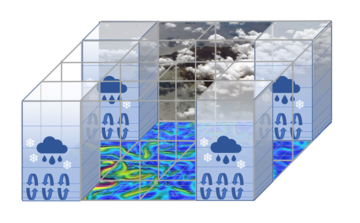This introduction is adapted from an article written for the DTC newsletter by Michael Ek, Ligia Bernardet, Grant Firl, Kathryn Newman, Lisa Bengtsson, Judith Berner and Hannah Christensen
The “Model Uncertainty-Model Intercomparison Project” (MU-MIP) is an international effort to better understand model-physics uncertainty, and how to represent it in stochastic physical parametrisations. After all, physical parametrisations provide an approximate solution to physical processes occurring in a grid-box and are, as such, a source of forecast model uncertainty due to a large variety of factors, e.g. unresolved subgrid-scale variability treated as a grid-box mean, unknown parameter values, physical processes which have been excluded, structural errors, incomplete calculations of processes or inherent process uncertainty.
While stochastic physics schemes are often tuned using ad-hoc methods, objective methods derived from physical constraints can be used to better inform the development and improvement of schemes. The uncertainty in parameterizations may then be addressed by stochastic methods, which aim to select a random state consistent with the resolved state.
MU-MIP seeks to inform the development of deterministic and stochastic schemes, by comparing state variables and tendencies in a convection-permitting high-resolution model simulation against a lower-resolution parameterized-convection model simulation. This is done by “coarse-graining” a high-resolution simulation (i.e. computing spatio-temporal averages) onto a grid of a lower-resolution simulation. The premise here is when the parameterizations work perfectly, the statistics of the state variables in the coarse-grained higher-resolution simulation should match those of parameterized lower-resolution simulations. In reality, however, discrepancies are often discovered when performing this type of comparison, where such discrepancies can then be used to improve the physical parameterizations. Additionally, the high-resolution distribution offers useful information about the subgrid-scale uncertainty that helps to objectively inform stochastic parameterizations.
MU-MIP participants will run an array of approximately 40,000 Single Column Model (SCM) simulations forced by coarse-grained high-resolution model output (Figure 1), initially from the DWD ICON (3-km) model. In order to use this forcing data, the SCMs will ingest forcing fields using the DEPHY format, a standard agreed upon at the International Workshop for SCM/LES comparisons organized and hosted by Météo-France in June 2020. The use of the DEPHY format is key for complementary initiatives towards improvement and tuning of model physics.
Scientists from a number of national and international centers have committed to participate in MU-MIP, including University of Oxford, University of Reading, the UK MetOffice, the European Centre for Medium-Range Weather Forecasts (ECMWF), Météo-France, Deutscher Wetterdienst (DWD, German Weather Service), NOAA’s Physical Sciences Laboratory (PSL), NCAR’s Mesoscale and Microscale Meteorology Laboratory (MMM), and the Developmental Testbed Center (DTC). It is not too late to get involved - please email Hannah Christensen for more information or to find out about our next meeting.

High-resolution model output (small grids) is coarse grained and mapped to grid (large boxes) to provide column forcing to drive an array of SCMs.